Kristin Holt's Blog, page 33
November 5, 2015
Victorian Fountain Pens
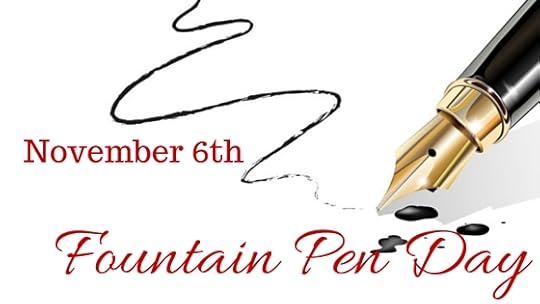
Did you know?
Taking place on the first Friday in November each year, Fountain Pen Day is celebrated by enthusiasts worldwide as a time to embrace, promote, and share the use of fountain pens.
FRIDAY NOVEMBER 6, 2015
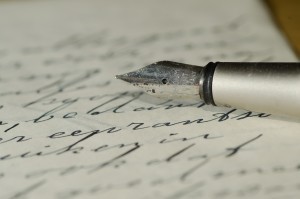 https://www.facebook.com/FountainPenDay
https://www.facebook.com/FountainPenDay
Fountain Pen Day has its own Facebook Event Page. Apparently it’s quite a big deal.
In simplest of terms, a fountain pen is a nib pen that, unlike its predecessor, the dip pen, contains an internal reservoir of water-based liquid ink. The pen draws ink from the reservoir, through a feed, to the nib and deposits it on paper via a combination of gravity and capillary action. ~Wikipedia
![Fountain Pen Patent Drawing from 1867. [Image: Public Domain]](https://i.gr-assets.com/images/S/compressed.photo.goodreads.com/hostedimages/1446876428i/16920146.png)
Fountain Pen Patent Drawing from 1867. [Image: Public Domain]
Pens with reservoirs have been available since the 17th century, but the process of developing a reliable pen was slow-going. The role that air-pressure played in the operation of ink-filled pens wasn’t well understood, so it took until the mid-19th century for the invention of a pen that could withstand the highly corrosive ink. Many patents were issued in the mid-19th century to various inventors. By the late 19th century, fountain pens had become common place, effective, and beautiful writing implements because of three key inventions: iridium-tipped gold nib, hard rubber, and free-flowing ink.
Victorian-era inventors fought to overcome the challenges of leakage, sediments in ink, the corrosive nature of inks, and the messy procedure of refilling by means of an eyedropper. The Industrial Revolution was in full-swing and eventually methods of mass production were perfected, allowing for reduction in costs and the reduction of prices. The invention of a new machine made the mass production of cheap, robust steel pen nibs possible, thus making pens available to those who previously could not afford to write. This boon is credited with encouraging the development of education and literacy.
Why are fountain pens popular now?
Fountain pens seem hopelessly geeky to the uninitiated. Why bother with an expensive, finicky pen when most of us do all of our writing on keyboards and touchscreens anyway? And what’s wrong with a ballpoint?
But there are significant advantages to using one, other than it looking beautiful on your desk. Writing longhand is not only more pleasant, since you don’t have to exert as much pressure on the page, but also more thoughtful. Because you’re using a lighter grip, it’s easier to add your own unique touch to your script. Fountain pens are also more environmentally friendly — the same pen can be used for a lifetime instead of joining the other cheap ballpoints in the trash year after year. [source]
They’re apparently cool. Or hot. Whichever term currently means stylish and hip and contemporary. Last March Ed Jelley argued 8 Reasons Why You Should Write With a Fountain Pen. My favorite one: improved penmanship.

As an author of historical romance, I often find myself immersed in census records (and others) from the 19th century, researching everything from occupations to names actually given babies in certain eras and regions of the country to taxes paid or values affixed to property and reasons doctors gave for deaths. I’ve had to work at deciphering 19th-century handwriting. It’s not as easy as it might seem.
![Spencer's Book on Penmanship, published 1866 [Image: Public Domain]](https://i.gr-assets.com/images/S/compressed.photo.goodreads.com/hostedimages/1446876428i/16920148.jpg)
Spencer’s Book on Penmanship, published 1866 [Image: Public Domain]
Some resources have made it easier, such as the Spencerian Penmanship books. Spencerian Script is a script (or penmanship) style used in the United States from approximately 1850 to 1925 and was considered the American standard for business correspondence prior to the widespread adoption of the typewriter. Spencer’s Book on Penmanship was published in 1866.
The image, below, is a surviving sample of Spencerian penmanship. It’s gorgeous and reminds me of the pristine form of my grandmother’s and grandfather’s handwriting. Penmanship of this quality seems to be something of a bygone era, achieved by and large by a focus in education and by the writing implement itself. Notice the heavier strokes noted in the D in Dec (top line) and the lower curve of the S in “Dear Sir”, accomplished by the flexible nature of the fountain pen’s nib.
Perhaps there are solid reasons– beyond fondness for all things Victorian– to enjoy fountain pens… and to set aside one day each year (November 6th) as Fountain Pen Day.
I’m so fond of fountain pens, Spencerian script, and quality penmanship, that my guests at the first-ever Salt Lake City Readers Luncheon, tomorrow, will find a fountain pen and a Spencerian Copybook (practice book) within their gift bag from me.
![Enduring example, twenty years after Platt Rogers Spencer's death, of Spencerian script from December, 1884. [Image: Public Domain]](https://i.gr-assets.com/images/S/compressed.photo.goodreads.com/hostedimages/1446876428i/16920149._SY540_.jpg)
Enduring example, twenty years after Platt Rogers Spencer’s death, of Spencerian script from December, 1884. [Image: Public Domain]
Copyright © 2015 Kristin Holt, LC
.
November 2, 2015
Silver Belles and Stetsons “BIRTHDAY”
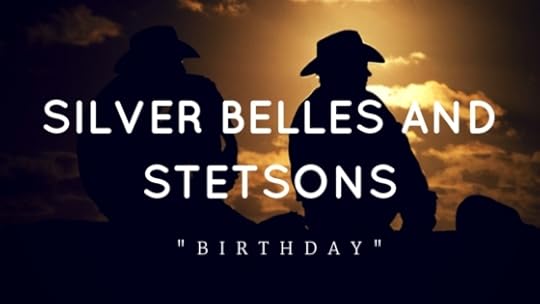
Today, Silver Belles and Stetsons was officially “born”.
Release Day: 11-2-15
.
Today, I’m particularly honored by a review posted on Goodreads:
[ I received this book free from one of the authors in this anthology and I thank them for their generousity. In exchange, I was simply asked to write an honest review, and post it. The opinions I have expressed are my own. I am disclosing this in accordance with the Federal Trade Commission’s 16 CFR, Part 255 “Guides Concerning the Use of Endorsements and Testimonials in Advertising”]
This ten novella bundle of Christmas romances are certainly something completely different from my usual read. I really loved it, especially Kristin Holt’s ” Drifter’s Proposal”. Each story dealt in its own way about wonen’s roles in the “old west” and how not only men were struggling in the expansion of the country, but their place in it.
And, they are all sweet romances on top of it. It’s a great book to cosy up to with a cup of something warm to spread the good cheer. [all SIC]

Today, I’m most grateful to readers who trust me enough to buy my title– often twice (as a stand-alone that released about three weeks ago and also the whole anthology). I’m basing this assumption of “twice” purchased on the “Customers Who Bought This Item Also Bought” space at the bottom of Silver Belle’s product page on Amazon.
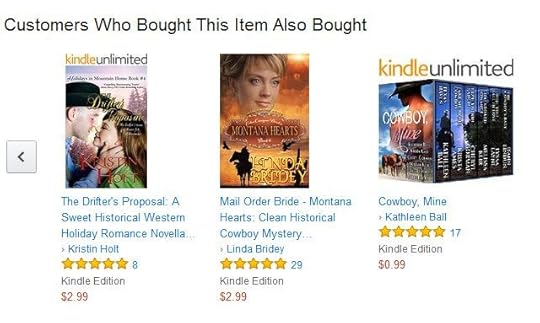
I’m most grateful to readers who’ve read and reviewed The Drifter’s Proposal. As of this article’s publication, Amazon reviews of this title are 4.9 out of 5 stars (over 8 reviews). I’m equally thrilled by 5 ratings on Goodreads with a 4.6 average (where 4 = really liked it and 5= it was amazing).
Reviews from readers are valuable feedback that informs me (and all authors) how a given book is received, whether it reached readers and touched them… or if it fell short. Reviews inform other readers on many, many important factors. But that’s a subject for an upcoming blog post.
Today, I simply wanted to acknowledge it’s Release Day, Silver Belles and Stetsons‘ Birth Day, and thank readers for buying, reading, and (hopefully) reviewing.

With heartfelt gratitude and appreciation,
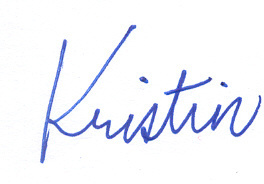
 FREE Peek Inside The Drifter’s Proposal: Cherry Pie Scene
FREE Peek Inside The Drifter’s Proposal: Cherry Pie Scene
NEW RELEASE: Coming November 2nd (Preorder Available)
Copyright © 2015 Kristin Holt, LC
.
October 31, 2015
FREE Peek Inside The Drifter’s Proposal: Cherry Pie Scene
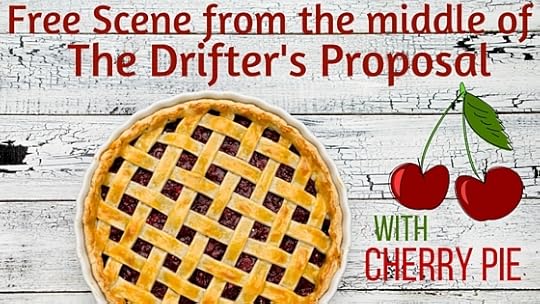
My last two blog posts have led up to this FREE scene I want to share with you from the middle of The Drifter’s Proposal:
Butter-making in the Old West
100+-Year-Old Never Fail Pie Crust Recipe
I’m pleased to share the first scene of Chapter Four. (This novella has just ten chapters, so this segment falls relatively “middle”.)

Copyright © 2015 Kristin Holt, LC
USUALLY, SATURDAY late afternoons saw a brisk business. Folks came in to buy fresh yeast rolls and pies for Sunday dinners. But with snowflakes the size of pennies tangling in the wind, they’d be lucky to see one-fourth their usual business, so Adaline baked accordingly.
She removed another pair of bubbling, perfectly browned dried cherry pies from the ovens and set them on the work table to cool alongside six others already setting up. She slid buttered tins of rolls into the available ovens.
Typically, it wouldn’t be dark ‘til half-past four, but she’d lit a lamp near two-o’clock as the storm worsened.
Mr. Malloy had become so fully absorbed in the ledgers, neither building storm, pie baking, nor memories of a kiss could distract him. From all she could see, he dug into ledgers with the same utter concentration he focused on savoring baked goods. Adaline tried to avoid disappointment.
That first kiss had been…
Everything.
More than she’d imagined.
Yet he worked as if she weren’t present. He traced a blunt forefinger over the entries, paused to tabulate. He opened two previous ledgers and compared. He’d removed spectacles from his shirt pocket and pulled the wire ends behind his ears when he’d first tucked into the project. The lenses winked in reflected lamplight. He jotted down several lines of notes.
The minute she had a stew for supper simmering, six batches of rolls baked and on cooling racks, and sent Juliette upstairs to check on Mother, she decided to ignore Mr. Malloy and tackle the next project on her to-do list.
She withdrew a clean sheet of paper and fountain pen from the cabinet and pulled a stool to the work table in the center of the kitchen. She folded the sheet of paper crisply down the middle, top to bottom, and labeled the left column KNOWN, the right, UNKNOWN.
She penned Father, March 4th, Denver in the KNOWN column.
First National Bank, mortgage = $700.00.
In the same column, Mother says no loan.
From memory, she jotted down the Denver address she’d seen in Papa’s day book.
Malloy had said he’d trailed Lockhart to the hotel, so she jotted that down. What had he learned from the hotel clerk? Or the Western Union telegraphist? She didn’t know yet.
She drew a breath, steeled herself to list all she could think of in the UNKNOWN category.
Hotel clerk…? Telegraphist…?
Lockhart, bank employee?
Why: Lockhart call on Saturday?
Reason Papa needed money?
Money went… ?
Father’s copy, documents. This would have been so much easier if Papa had simply told his family what he’d done.
Mortgage ledger? Knowing her father, he’d hidden it with his copy of the mortgage. She’d continue searching the residence and shop for his hiding place. If they were here, she’d find them.
She glanced up the moment Mr. Malloy stretched, removed his spectacles, and set them on the open ledger before him. He searched the kitchen as if he’d completely forgotten where he’d been, but the second his gaze settled on her, he smiled.
Dazzling, like clear midday sunlight glinting on fresh-fallen snow. Blinding. Beautiful. Almost painful to the eye.
Drat. If she kept losing bits of her heart to him, it wouldn’t be long until she had nothing left.
“What delicious things are you baking now?” He inhaled with appreciation, rose and approached. “Supper? Fresh bread and cherry pie? Please tell me some of those delicacies are for me.”
His attention never deviated from her face, nor did he give her a chance to respond, before he said, “What are you working on?”
“Figuring out where to go next, what to do.”
He stood behind her and rested both hands on her shoulders. “Good idea.”
She cleared her throat. “I think better on paper.”
He leaned in to read all she’d written. He probably didn’t intend to snuggle so close, but the warmth of his solid body, pressed against her back brought new, delicious sensations.
Yes, his kiss had been wonderful… but he’d become so… close. His ease and comfort in touching her had grown like Jack’s mythical beanstalk, from a mere seed into full bloom.
Did courting couples behave this way? She had no idea.
Did he assume more familiarity now, because of that kiss? Even after he’d rejected the mere thought of marriage, especially to her?
Confusion marred the sheer grandeur of his closeness.
He tapped the notes she’d made in the KNOWN column and she forced her attention to the subject at hand. “I take it March fourth is the date on the mortgage papers.”
“Yes. Pa jotted the address in his day book.”
“Hmm. When we go to the bank in Denver, we’ll trace the address.”
She’d never had reason to go more than ten miles in any direction from the bakery, never traveled by train. The thought of Denver City both thrilled and terrified her. At least she’d have Mr. Malloy at her side.
She wrote TO DO mid-page and started a list beneath.
Call on First National Bank of Denver, and trace address.
Speak to Papa’s friends, she wrote. “Maybe one of them knows something.”
“Good thinking.”
“Papa was friendly with all businessmen in town and close to many. Because we’re in distress, someone might confide—” Her throat closed up and she fought to swallow.
Mr. Malloy’s thumbs found their way onto the bare skin of her neck. He tugged on the little hairs that slipped out of her bun and raised goose flesh. “I’m sure you’re right.”
He tapped the QUESTIONS column with a blunt, strong forefinger. “While we’re talking to the neighbors, let’s find out if any of ‘em carried his monthly payments to the bank in Denver.”
That caught her by surprise.
“Sure,” he said. “From March ‘til the day he died, he must’ve made regular payments. I talked to the Western Union telegraphist on duty, and he swore your pa never wired money to Denver or anywhere else.”
She wrote no wire transfers and lined through the question about the telegraph operator.
“You’re sure your Pa never made trips out of town, say, every other month?”
“No. I’m certain. He was always here, spent seven days a week with us. Shipments come by train for ingredients we can’t buy from local farmers. He never went on buying trips.”
Malloy seemed to think that through, his gaze focused at some great distance for perhaps fifteen seconds.
He touched her arm, just a nudge, but it felt like a caress. “That’s another thing that don’t make sense. He died when, early September?”
“Yes. The sixth.”
“Lockhart said the payments are sixty days past due, so that’d put the last payment roughly middle of October.”
How had she missed the obvious? “Who made the September and October payments?”
“My thoughts, exactly.”
She penned the question on the note paper. Paused, thought it through. “Could he have taken this mortgage for someone else in town? Someone whose credit couldn’t get them a loan?”
“Maybe. But you tell me. Who would he sacrifice everything for?”
Until today, she would’ve easily responded, his wife and daughters. She thought of Mr. Malloy, who’d easily sacrificed a great deal for her… a woman he didn’t want to wed, barely knew, and had no obligation to assist. The comparison left her confused.
“I don’t know.”
“Just wondered if you have a sibling I’ve not met, say, a brother who wants to buy a tract of land?”
“No.” Bleak emptiness settled, bone-deep. “But never mind that idea. He wouldn’t have taken a loan for someone else.”
“Okay. Let’s see if anybody knows anything. In this weather, we’ll find most home. Unless they’re out searching.”
Poor Noelle Finlay.
Adaline had contributed to the rescue efforts the only way she knew how. Baking a dozen loaves to help feed the posse, and wishing she could do more to help.
She focused hard on the to-do list. So many questions. They piled higher and deeper, just like drifts of snow against buildings. More and more questions, and still no answers.
Malloy rose. “We start with the neighbors. Everything else can wait ‘til it’s too late to knock doors. If it’s okay with you, I’ll ask around. You stay here and take care of business.”
What he hadn’t said meant even more— he’d leave her here, out of the weather, warm and safe.
He pulled her to her feet. “Mind if I join you for supper? It smells mighty good, and I’d like to share everything I learn with you.”
She could have kissed him. Could he be any kinder? “We eat at six-o’clock. Closing time.”
“Yes, ma’am.” He shrugged into his coat.
He nearly had it buttoned when she remembered to ask, “What did you find in the business ledgers?”
Will you kiss me once or twice?
He lifted his hat from a peg by the back door. His blue eyes twinkled as if lit with silver sleigh bells. “Don’t know, yet.”
She fought to hide an avalanche of disappointment.
“Might take a few more hours of careful assessment.”
She tried to smile. “No rush.”
One long stride brought him near. “Darlin’, I hate to raise my rates, when we already have an agreement, but…” He smoothed fingertips over her cheek, along her jaw, and finally came to rest with a knuckle beneath her chin. “…twice the work ought to be worth twice the pay.”
Joy effused every limb. “Indeed.”
She settled her hands at his narrow waist, wishing he hadn’t put on his bulky winter coat. How she’d love to hold onto him.
He lowered his head, just a bit. “Sound reasonable, Miss Whipple?”
He could triple his rate, and she wouldn’t complain. “Yes.”
“How ‘bout an advance?” He brushed his nose against hers, just a whisper of movement, but golly, did it ignite sparks of sensation. “It’d keep me warm, ‘til then.”
“Adaline?”
Mother?
Adaline spun to face her parent, yanked away from the most delicious almost-kiss, ever. Worse timing had never existed.
Malloy mentioned extracting additional kisses, and her entire body sang a jubilant chorus of hallelujah. No wonder she’d failed to hear three sets of shoes on the stairs.
The trio had, apparently, traversed the entire staircase, for Mama stood on the second-to-bottom step, the twins flanking either side, just below.
Adaline gaped in panic. Apparently, having nothing to say, she closed her mouth.
Mr. Malloy rested a steadying hand on Adaline’s shoulder, stood tall at her side, and smiled at Mother. Oh, he so didn’t know what he was in for.
After all Mama had just witnessed, she knew this wretched day was about to get a whole lot worse. The sharp side of Mama’s tongue could cut a swath a mile wide.
Malloy would never kiss her again. The opening strains of Mother’s lecture on decorum, propriety, and moral decency would burn his ears. He’d leave town on the four-o’clock train, blizzard be damned.
“Mrs. Whipple, it’s good to see you up and about. Pleasure to meet you, ma’am.”
How could he sound genuinely happy to meet her mother?
Mother had bathed, fully dressed for the first time in weeks, and had artfully arranged her hair as she did for only the most special of occasions… like Christmas, an engagement party, or wedding.
Adaline blanched. Malloy might want a kiss or two, but he didn’t want to marry her. Mama would be utterly beside herself.
Copyright © 2015 Kristin Holt, LC
If you enjoyed this scene, please forward the link to others who enjoy Sweet (Rated G/PG) Western Historical Romance.

Have YOU ever been caught kissing at a most inopportune moment?
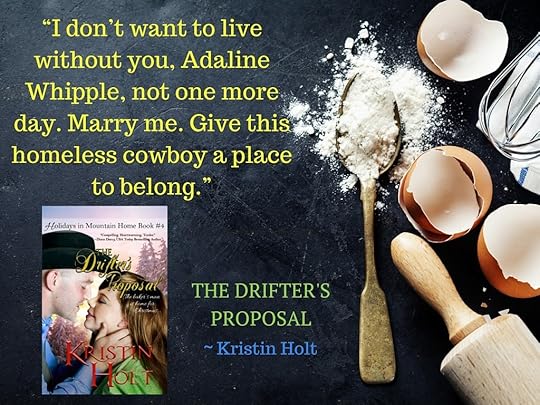
Whether you’ve read the whole of The Drifter’s Proposal or not, I’m genuinely interested in your thoughts. Please don’t hesitate to drop me a note or leave a reply to this article. I enjoy connecting with readers. Thanks!
Related Article: Butter-making in the Old West
Related Article: 100+-Year-Old Never Fail Pie Crust Recipe
The Drifter’s Proposal is available for kindle and in paperback. For a limited time, it’s part of the Silver Belles and Stetsons Anthology (for Kindle, only). Both kindle editions are FREE Reads with kindleunlimited.
Copyright © 2015 Kristin Holt, LC
October 28, 2015
100+-Year-Old Never Fail Pie Crust Recipe
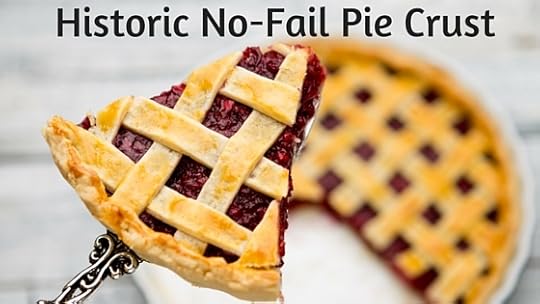
Many reasons contribute to our immigrant ancestors’ penchant for pie-baking. Simple, honest, historic ingredients. Traditions of European countries. Affordability. And many more.
I had the superior benefit of a mother-in-law who’s a skilled baker and taught me the mysteries of pie crust nearly thirty years ago. I’ve slowly refined my methods, skills, and comprehension of how to make the best pastry. While researching and writing The Drifter’s Proposal (set mostly in Whipple’s Bakery in my fictitious town of Mountain Home, Colorado, circa 1900; The Drifter’s Proposal is contained within the Silver Belles and Stetsons Anthology) I stumbled across a vintage pie crust recipe that fully changed everything I’d previously believed about pie crust.
OK… not quite everything.
But this recipe impressed me. It’s flaky, tender, easy to work with, and yields a spectacular taste and presentation.

HISTORIC NO-FAIL PIE CRUST RECIPE
INGREDIENTS:
4 cups all-purpose flour
3 Tbsp. white sugar
2 tsp. salt
1 & 3/4 cups real dairy butter
1 egg
1/2 cup cold water
DIRECTIONS:
1. In a large mixing bowl thoroughly combine all dry ingredients (flour, sugar, salt).
2. Working with clean hands, rub room-temperature butter into flour mixture until fully incorporated. (This means just what it sounds like. Work the room-temperature butter into the dry ingredients by working it between thumbs and first and second fingers.)
3. Thoroughly blend cold egg and cold water together (I used what my grandmother didn’t have… a bullet blender). But a wire whisk or fork will do. Pour liquid into buttered flour combination and stir until just barely moistened.
Note: One of the biggest tricks to tender pastry is to NOT overwork the dough after water is added. Handle it all you need to before water is added.
4. Wash kitchen counter with dish soap and water, rinsing (with cloth) well (as if washing a dish… after all, that’s what it’s about to become). Dry off clean, rinsed counter top.
Note: this pie pastry recipe does not need to be refrigerated before rolling. That’s one huge benefit over egg-less recipes. In my experience, one of the reasons this recipe is “no-fail” is the pastry dough tears far less easily, making handling and transfer to pie plate a snap.

Punched Tin Panel Doors on Antique Pie Safe: www.antiquecountryfurniturestore.com
5. Sprinkle flour over work area. Divide dough into two portions for 9-inch pie plates, or into at least thirds for 8-inch pie plates. THINK THIN: pie crust is superior when thin. The thinner the better.
6. Using rolling pin, roll dough in various directions to keep a general circle shape. Use a bit more flour to keep the rolling pin from sticking, as needed. When the crust is as thin as reasonable, roll the pastry loosely around rolling pin to enable transfer from the counter top to the pie plate. Settle pastry into the pie plate, working it into position. With a butter knife, cut a full inch or a little more beyond the edge of the pie plate. (You need the extra to flute the edges or to fuse top and bottom crusts adequately.)
7. Prick the bottom and sides of the pastry in pie plate with tines of a fork, roughly every 1/2-inch. This prevents air bubbles from becoming trapped between pie plate and pastry, and misshaping your beautiful pie.
If you’re fully baking an empty one-crust pastry for a no-bake pie (such as chocolate créme), bake the empty crust at about 375º to 400º, checking every 10 minutes (or less) for bubbles. Pierce any puffs with fork tines so pastry remains as flat as possible. Our great-grandmothers didn’t have fancy parchment paper or pie weights.
8. For a two-crust fruit pie, fill the pie to 1/4-inch from the upper rim of pie plate. Roll the top crust in much the same manner as the first; transfer onto the top of filling. Cut the edge at the same 1-inch extension as the lower crust (note that you’ll need a smaller diameter for the top crust). Dip finger in a small cup of cool water. Moisten the lower and upper crusts where they meet, extending over the edge of the plate. Fold this extension under, all the way around and flute the edges using thumb and forefingers of both hands to create the wave-like appearance. This effort seals the crusts so filling is less-likely to leak out and boil over in your oven.
Cut venting slits in the upper pie crust (at least 4) in a decorative wheel-spoke fashion, allowing steam to escape (so upper crust doesn’t distort). Using a pastry brush, paint the upper crust (avoid the outer fluted rim as it tends to over-bake) with milk. Sprinkle the top liberally with sugar. Both the milk and sugar assist the crust in browning nicely.
To make a lattice top-crust, slice consistent-width thin strips (perhaps 1/4-inch) and starting on one side lay strips, alternating every-other-direction and folding back previously laid strips as necessary to form lattice appearance. Note: You’ll still want to use water to seal where the lattice strips touch the bottom crust and flute the pastry dough around the edges. Note: the butter and egg also improve the browning of the pastry over an egg-less or butter-less recipe.
Even perfectly-filled pies often overflow. It’s just the nature of flaky pastry and berries. I strongly recommend lining a jelly-roll baking sheet (with short sides) with foil and setting the pie in the center to bake. The foil makes cleanup a snap.
9. Bake per directions in your pie filling recipe. As a general rule, two-crust pies require about 50 to 60 minutes in a 375º oven to ensure both top and bottom crusts are fully baked, become golden brown, and the filling (if not cooked ahead, such as canned fruit filling, for example) is fully cooked and has a chance to thicken.

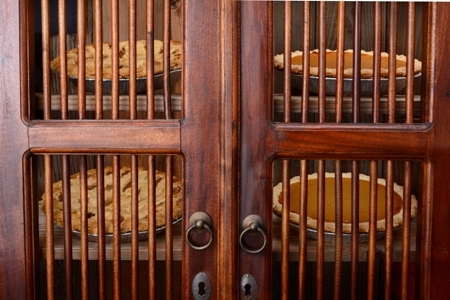
Close-up of an Old Fashioned Pie Safe
Book Description: The Drifter’s Proposal
Related Article: New Release (The Drifter’s Proposal) Opening Scene
Related Article: Butter-making in the Old West
Related Article: Book Review–Things Mother Used to Make: A Collection of Old Time Recipes, Some Nearly One Hundred Years Old and Never Published Before
Related Article: Old Time Recipe– Shortbread
Related Post: An Honest-to-goodness Pioneer Recipe
Coming next: a peek at the scene in The Drifter’s Proposal where Adaline Whipple bakes (dried) cherry pie (it is December, 1900, in the Rocky Mountains).
Copyright © 2015 Kristin Holt, LC
October 25, 2015
Butter-making in the Old West
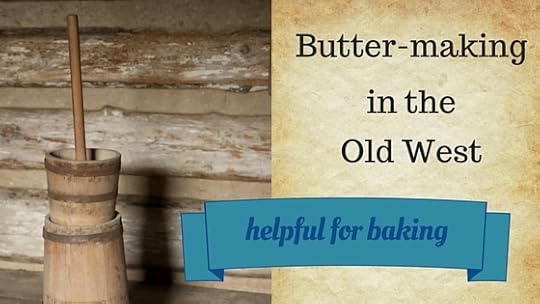
Butter was not essential to baking, and still is not. But butter tastes good and has superior “mouth feel”. It’s flavorful, delicious, and like any dietary fat, serves important purposes in foods like bread, biscuits, pies, and cookies.
In the “Old West” days, whenever a hog was butchered, economical folk would render every bit of fat from the animal for use in candle-making, soap-making, and the highly valued leaf lard (the soft fat from around the loin and kidneys of the pig). When properly rendered, leaf lard is a premium baking ingredient, odorless (doesn’t smelly “porky” at all), and super-spreadable at room-temperature).
Our great-grandmothers baked regularly with lard to make the flakiest of pie crusts, tender yeast bread, and light-as-air biscuits. But hogs were typically butchered just once a year, in the late autumn when cooler temperatures decreased spoilage of the large quantities of meat, but not so cold to prevent this out-of-doors work from occurring.

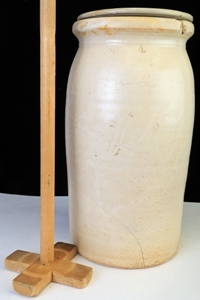
Antique Crockery Butter Churn
Butter-making, in contrast, was a chore to accomplish about every-other-week. Milk pails were allowed to sit so the fat rose to the surface where it was skimmed off prior to consumption. Cream would be saved until a large enough quantity could be had for churning into butter. I remember visiting my great-grandmother and finding a large enamel-coated flat-bottomed bowl filled with milk in her electric refrigerator. I couldn’t believe she had fresh milk, would wait for the cream to rise, and intended to churn her own butter. Why not buy it at the grocery store like my parents did?
I don’t remember her answer, but I do recall her disappointment I had no idea where butter came from, nor the simple housekeeping chore of putting foodstuffs to the best use possible. Why drink whole milk and go without butter for spreading on toast or whipping into a buttercream icing? In my own defense, I was less than 10 years of age and my exposure limited.
Churning butter isn’t as easy as they made it look at summer camp when we shook baby-food jars half-full of whipping cream.
Why?
Butter “comes” out of the cream at about 55 to 65 degrees. Try finding 60 degrees– ever– in the an Arizona desert summer. Or struggling to raise a wooden or crockery churn, even by aid of boiling water, in a Rocky Mountain winter.
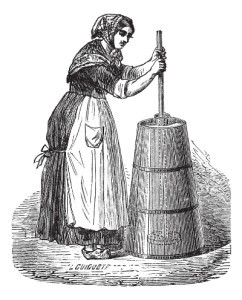
Old engraved illustration of a woman churning butter.
“Let the cream be at the temperature of 55° to 60°, by a Fahrenheit thermometer; this is very important. If the weather be cold put boiling water into the churn for half an hour before you want to use it; when that is poured off strain in the cream through a butter cloth. When the butter is coming, which is easily ascertained by the sound, take off the lid, and with a small, flat board scrape down the sides of the churn, and do the same to the lid: this prevents waste. When the butter is come the butter-milk is to be poured off and spring water put into the churn, and turned for two or three minutes; this is to be then poured away and fresh added, and again the handle turned for a minute or two. Should there be the least milkiness when this is poured from the churn, more must be put in.“
.
“The butter is then to be placed on a board or marble slab and salted to taste; then with a cream cloth, wrung out in spring water, press all the moisture from it. When dry and firm make it up into rolls with flat boards. The whole process should be completed in three-quarters of an hour. In hot weather pains must be taken to keep the applesauce from reaching too high a heat. If the dairy be not cool enough, keep the cream-pot in the coldest water you can get; make the butter early in the morning, and place cold water in the churn for a while before it is used.”
.
Source: Household Cyclopedia, 1881
Freshly churned butter must also be separated from the buttermilk (good for all kinds of baking purposes, like buttermilk pancakes and buttermilk biscuits) then rinsed thoroughly and repeatedly until all traces of milk are removed. Otherwise, the butter will spoil quickly and end up inedible. Instructions and “receipts” of the time caution thorough repetitive rinsing.
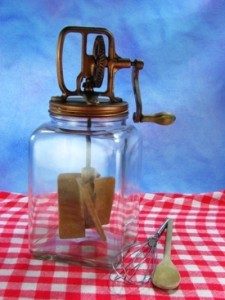
Antique Butter Churn from the early 1900’s.
It wasn’t until the early 1900’s that butter churns made a leap forward in technology with hand-crank, small-quantity glass jars (about 2 quarts) that could whip cream in one minute and make butter in two. Nathan Dazey, whose firm, the Dazey Churn & Manufacturing Company, produced small, beautiful churns made of glass. The devices were expensive yet sold well.
The reason for small churns was that much of the butter made in homes was sweet or unsalted butter. Sweet butter was very perishable, especially before the days of modern refrigeration. It often absorbed odors and started to spoil, gaining an off taste within a day or two. To avoid this butter was churned in small quantities that could be used rapidly.
I can’t imagine the hard work of churning butter roughly 25 times per year… on top of milking the cow(s), washing the churn, keeping the milk pails clean, and trying to keep the diary products as fresh as possible in the spring house or icebox. Dairy products, including butter, often took on the flavors of plants the cows ate, burning some butter (and milk) bitter. No wonder so many ditties and poems were common in the 19th century to help the chore move along as well as teach caution in preparing sweet butter. (Remember “..make her bitter batter better…”?)
While researching and writing my recent title, The Drifter’s Proposal, it was easy to determine my characters (Adaline Whipple and Whipple Bakery) would purchase butter ready-made from neighboring farmers, along with flour ground at a local mill, milk from a dairyman. My charcters worked hard from hours before dawn to dark (especially in December when the book is set) simply baking. Who had time to churn the quantities of butter they’d require, simply to bake specific recipes that most required butter? Not my characters– and not me! I believe I’ll bake, instead of churn.
Up next: a flaky, no-fail pie crust recipe (using butter) that’s more than 100 years old.
Copyright © 2015 Kristin Holt, LC
October 21, 2015
THE FOURTEENTH QUILT by Robyn Echols
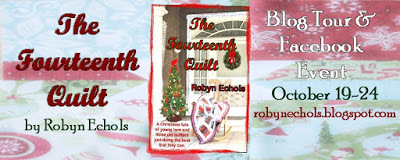
I’m delighted to introduce Robyn Echols, author of The Fourteenth Quilt: A Christmas tale of young love and three old quilters just doing the best that they can. Robyn writes sweet, clean romance and speculative/paranormal time travel novels. Under her pen name Zina Abbott, she writes western historical romance published by Prairie Rose Publications and a new contemporary war romance series beginning with Family Secrets.

About The Fourteenth Quilt:
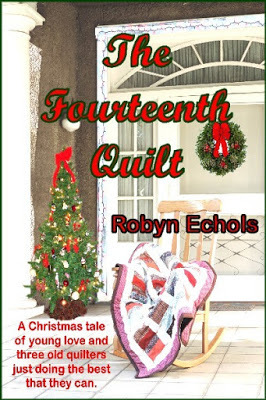 Annie, Celia and Lynn are all that are left of the Relief Society quilting class, but they are still determined to make baby quilts for the new mothers at church.
Annie, Celia and Lynn are all that are left of the Relief Society quilting class, but they are still determined to make baby quilts for the new mothers at church.Annie, who is just south of eighty years old, calls the quiltsters (short for quilting sisters) together to ask for more. She wants to make lap quilts to give to some of the “forgotten” oldsters she sings to each week at the nursing home—something to wrap them in love at Christmastime. It’s a good idea, but the trio discovers that life and making quilts don’t always go as planned.
The quiltsters discuss recipes and quilting ideas including a crocheted cat mat to use up their fabric selvage and trim scraps, all of which they share in the book.
Sarah and Brian meet at the university. Their first date is after Sarah’s First Saturday Block of the Month class she attends with her mom at the local quilt shop. Their romance grows, and they plan their future together—a plan that will require them to be separated for six months before their wedding. But, can they bear to be apart that long?
What wraps together this Christmas tale? The Fourteenth Quilt.

Excerpt #4: (The Beast)
“I think we’re finished. Let’s give it the once over and then move The Beast to the quilt frame.”
“Oh, no!” Annie cried out as she inspected the fabric. “The Beast drew blood.”
“What?”
Lynn hurried over to study the three inch long pattern of red dots near the top corner. “That’s fresh blood. Which one of us is bleeding?”
They both inspected their fingers.
“It’s me,” Annie sighed. “Of course I felt the pricks as we pinned this thing in place, but I had no idea any of them were deep enough to make me bleed.”
The doorbell rang.
“It must be Celia,” Lynn said. “I’ll let her in and bring a Band-aid, a rag and my stain remover on the way back.”
“What are you doing?” Celia asked when she saw Lynn grab the spray bottle and rag from the laundry room.
“Annie accidentally dripped blood on The Beast. We need to get it out while it’s still fresh.”
Without another word, Celia broke into a run down the hall.
“Spit on it! Spit on it!” Celia shouted to Annie as she entered the bedroom.
Startled, Annie jerked to her full height, her eyes wide as she peered over the top of her glasses.
“I already bled all over The Beast. Now you want me to curse it by spitting on it?”
“It’s already cursed as far as I’m concerned,” Lynn muttered as she entered the room.
“No, I learned this in my biology class,” Celia explained. “The enzymes in a person’s saliva will break down and remove a person’s own blood. So, if you spit on a blood stain from your own blood, you can wash it out much better than even using a stain remover. Somebody else’s saliva won’t work on your blood as well as your own.”
“Learn something new every day,” Lynn said, shaking her head. “Start spitting, Annie. We are not buying another pair of sheets for The Beast.”
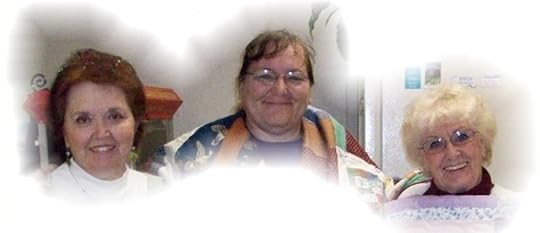

a Rafflecopter giveaway
About Robyn Echols:
Robyn Echols has been writing since she was in junior high school. By choi
 ce, she spent most of her evening hours in her “dungeon”, as her mother called her downstairs bedroom, writing stories, only joining her family in front of the television upstairs when her favorite programs were playing. She has spent hours learning and teaching family history topics, and focuses on history from a genealogist’s perspective of seeking out the details of everyday life in the past.Now Robyn resides with her husband in California near the “Gateway to Yosemite” and has fun researching and writing the books that she hopes will interest and entertain her readers. She writes Young Adult/New Adult and contemporary fiction under Robyn Echols and adult historical romance under her pen name, Zina Abbott.
ce, she spent most of her evening hours in her “dungeon”, as her mother called her downstairs bedroom, writing stories, only joining her family in front of the television upstairs when her favorite programs were playing. She has spent hours learning and teaching family history topics, and focuses on history from a genealogist’s perspective of seeking out the details of everyday life in the past.Now Robyn resides with her husband in California near the “Gateway to Yosemite” and has fun researching and writing the books that she hopes will interest and entertain her readers. She writes Young Adult/New Adult and contemporary fiction under Robyn Echols and adult historical romance under her pen name, Zina Abbott.

The author is a member of Women Writing the West, American Night Writers Association, and Modesto Writers Meet Up. She currently lives with her husband in California near the “Gateway to Yosemite.” She enjoys any kind of history including family history. When she is not piecing together novel plots, she pieces together quilt blocks.

Author Links: Website | Blog | Facebook | Twitter | Pinterest | Goodreads | Amazon Author Page
Quilt Gateway blog (See posts for September 2015)
The Fourteenth Quilt Facebook Page
The Fourteenth Quilt Pinterest Board
Purchase Links : Amazon | Barnes & Noble
October 18, 2015
Victorian Yeast Bread… Easier after the Centennial
![Opening Day Ceremonies at the Centennial Exhibition at Philadelphia. May 10, 1876. [Image: Public Domain, engraving]](https://i.gr-assets.com/images/S/compressed.photo.goodreads.com/hostedimages/1445336770i/16634897._SX540_.jpg)
Opening Day Ceremonies at the Centennial Exhibition at Philadelphia. May 10, 1876. [Image: Public Domain, engraving]
What does fluffy homemade bread have to do with the Centennial Celebration of the United States?
In December 1856, a professor of mathematics, philosophy, and astronomy in Indiana by the name of John L. Campbell, suggested to Philadelphia’s mayor that the United States Centennial be celebrated with an exposition in Philadelphia. The Centennial Expo was an enormous undertaking, managed by commissioners representing each state and territory in the United States. The 100-year old U.S. of A. had a good deal to show for itself, as the young nation had surpassed Britain in Industrial Revolution strides. Guests came from all over the world to witness the United States’ industrial and innovative prowess.
Among the consumer products first displayed to the public were: Alexander Graham Bell‘s telephone, the Remington Typographic Machine (typewriter), Heinz Ketchup, and Hires Root Beer.
Charles Elmer Hires, Philadelphia pharmacist and founder of Hires Root Beer, cultivated new customers at the expo by giving away free glasses of root beer. To make his product stand out, he called it the “temperance drink”.
Charles Louis Fleishmann operated with the same type of
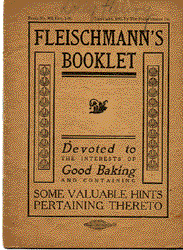
Fleischmann’s Booklet. Fleischmann & Co., 1906
marketing savvy. He offered pieces of freshly baked bread made with the world’s very first commercially prepared yeast from an exhibit modeled after a Vienna Bakery. An increase demand for Fleischmann’s yeast soon followed, bringing about the building of a Fleischmann plant on Long Island and then in upstate New York.
Charles and his brother Maximilian revolutionized baking in a way that made significant and positive differences in bread production. Peoples worldwide have been making bread for millennia. Yeast is a naturally occurring spore on the surface of vegetables and fruits and serves an essential process in the fermentation of wine. Before baker’s yeast became available in foil-wrapped packets from Fleischmann, bakers often employed sourdough starter techniques (natural yeast) or added grape mash and/or wine to bread dough, which would take a significant length of time to rise. Flesichmann’s fresh yeast could see bread dough adequately risen and ready to bake in a matter of hours.
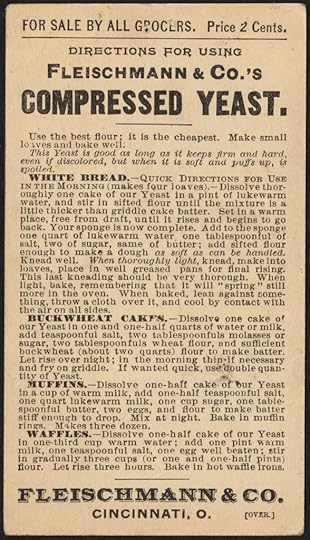
Directions for using Fleischmann & Co.’s Compressed Yeast. Year Unknown.
Studying bread-baking methods of the late 19th Century as I wrote The Drifter’s Proposal brought up several key concepts that surprised me.
I’m an experienced homemade bread baker. I know plenty about yeast breads (rolls, loaves, sweet, plain, multi-grain, all of it).
1. Rising times are significantly shorter in today’s recipes than when baking in the year 1900 (yeast preparations have changed).
2. Bread (in the 19th century) was the main part of the meal, and everything else was considered ‘condiments’. Meat, potatoes, vegetables… it all went with the bread.
3. Bakeries were most hesitant to sell sliced bread because it would go stale faster than a whole loaf. Bakeries, given the absence of preservatives and plastic bags, sold whole loaves and fought adamantly against newfangled developments such as the idea and forward-thinking concepts of bread slicers for convenience. (I played with this one a bit, as I really wanted to reflect today’s ability to buy a slice of delicious bread for eating, right now, in places like Great Harvest Bread Company).
4. I was genuinely surprised at the timing (early 1870’s) for commercially available yeast. In some ways it seems too early, and in some ways, too late. I found it fascinating that Fleischmann chose Philadelphia’s Centennial Expo as his way to spread the word and do so quickly and effectively.
5. I was even more surprised by the historic evidence that Fleischmann had to advertise, educate, and essentially convince bakers of the day that they needed his offered product. After all, methods employed for thousands of years still worked. Why buy packaged yeast?
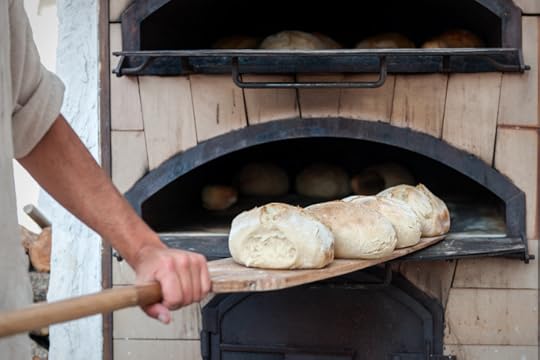
Baker using brick oven to bake bread.
I found the history surrounding bread making fascinating, rewarding, and a great deal of fun. I enjoyed setting The Drifter’s Proposal mostly within Whipple’s Bakery, my own small town bakery in my fictitious town of Mountain Home, Colorado. There’s simply something special about the homey smell of bread baking that makes a person feel like they’ve come home. The aroma worked a special kind of miracle for my homeless drifter Malloy, as the aroma of bread baking dredged up long-forgotten partial memories of his childhood home.
What connections does your memory make when you smell bread baking?
Bread Baking Made Easy: A master cook shares her recipes and secrets (Bookcraft, 1984) is a cookbook I received as a wedding gift in 1988. I learned a phenomenal amount about bread baking from this book, and have worn out my copy. This cookbook is a keeper, perfect for the novice baker, and can teach anyone to make delicious homemade bread.
The Drifter’s Proposal is available both as a stand-alone novella and within the Silver Belles and Stetsons anthology.
Related Post: New Release– Opening Scene Related Post: Book Review– Things Mother Used to Make (A Collection of Old Time Recipes) Yeast, Bread, & Bakeries, Old West Style
Copyright © 2015 Kristin Holt, LC
October 16, 2015
Coming November 1st…
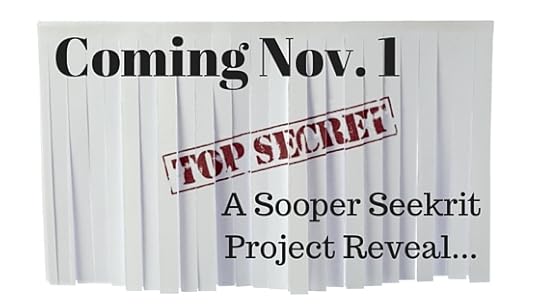
On Thursday, October 15th, the Pioneer Hearts Facebook Group made an intriguing announcement. This multi-author fan group is all about readers of western historical romance (of all heat/sensuality levels), and as of today is 1,449 members strong (only about 160 of which are authors).
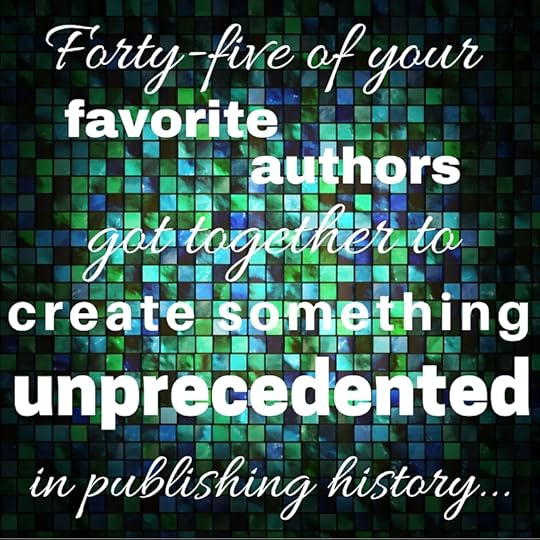
What’s unprecedented?
Publishing history… how?
What are they doing?
What are YOU doing?
On November 1st, the “Sooper Seekrit” project some Pioneer Hearts authors have been working on (for months!) will be revealed, at a Facebook Event (Party!). Mark this one on your calendars. You’re not only invited, you’ll want to BE there!
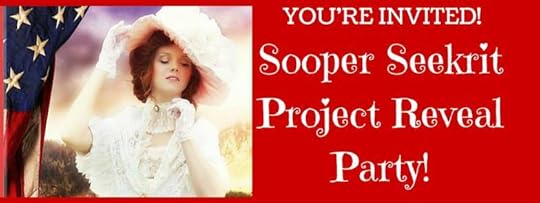 You are invited! To RSVP, and to attend the Facebook party itself, click here: https://www.facebook.com/events/1663311033925580/
You are invited! To RSVP, and to attend the Facebook party itself, click here: https://www.facebook.com/events/1663311033925580/
What: Sooper Seekrit Project Reveal Party!
When: Sunday, November 1, 7PM to 9PM (EST)
Where: ON that Facebook page link TIP: Save the Link! (digitally– like copy-and-paste and stick it in a Word doc on your desktop, add it to your ‘favorites’ or ‘bookmark’ it, write on a Post-It Note in good old-fashioned handwriting)
Why: Because ‘we’ have all the answers to your questions, beginning with WHY is 45 = 50? and ending with the project reveal itself… you’ll want to know about this project reveal that truly is unprecedented in publishing history. (No joke!) And… What’s a party without party favors?
beginning with WHY is 45 = 50? and ending with the project reveal itself… you’ll want to know about this project reveal that truly is unprecedented in publishing history. (No joke!) And… What’s a party without party favors?
How: Figure out what time it is at YOUR place when it’s 7:00 PM EST (Eastern Standard Time). Mark your calendar. Set a timer on your iPhone. Write yourself a Post-It Note and stick it to your computer screen and put another on the fridge. Log into Facebook, and go to the event page and participate!

1. Click “Refresh” often during the party.  New posts show up all the time, and Facebook won’t stay caught up and ‘auto-refresh’ often enough. To refresh, click on the circle-arrow on your web address (url) window.
New posts show up all the time, and Facebook won’t stay caught up and ‘auto-refresh’ often enough. To refresh, click on the circle-arrow on your web address (url) window.
2. Watch for new posts to pop up. Scroll up. You’ll see new threads (new images with a bunch of comments showing up below) appear frequently. Conversations may continue on a thread that’s been going for a while, and conversation will pick up fresh somewhere else. Scroll down and see what new conversation has taken place on a post lower down. Keep your eyes open.
 3. Read other peoples’ comments… it’s like attending a cocktail party and enjoying what other people have to say! One great way to “nod” and “smile” at each other is to acknowledge speakers by LIKING their posts. Often, much of the fun comes from the new people you meet, interacting and visiting and spending time with like-minded people.
3. Read other peoples’ comments… it’s like attending a cocktail party and enjoying what other people have to say! One great way to “nod” and “smile” at each other is to acknowledge speakers by LIKING their posts. Often, much of the fun comes from the new people you meet, interacting and visiting and spending time with like-minded people.
4. Plan to arrive on time (or a little early)… just like you would in the Real World. Facebook gatherings tend to begin right on time, and begin with a bang. You’ll want to be there! No harm in arriving early as there’s no doorbell to ring and the hostess isn’t actually still setting out the canapes. But if you have to sneak in late, no worries! Come on in and make yourself comfortable. Prepare yourself with a drink at hand, a bite to eat if needed, and put your feet up.
5. Stick around for as much of the party as you can! Very often hostesses rotate, and you’ll have exposure and time with different people as the party progresses. Prizes are frequently given out at intervals, and you won’t want to miss out on news, developments, give-aways, and various chances to socialize. If you simply can’t stay long, no worries. No need to even say goodbye (no one will hear the door shut behind you). That’s one of the beautiful things about FB. Drop in, stay as long as you can, and go when you need to.

I’ll definitely be at the Sooper Seekrit Project Facebook Event, and can’t wait to tell you about my involvement! Please consider yourself personally invited. Please come. It’ll be a blast!
Copyright © 2015 Kristin Holt
September 28, 2015
Book Review–Things Mother Used to Make: A Collection of Old Time Recipes, Some Nearly One Hundred Years Old and Never Published Before
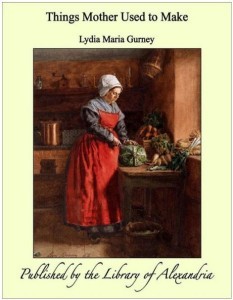

This title has been published with many different covers by many different publishers, particularly since it entered Public Domain. All of the displayed artwork represents the same recipe collection and same book content.
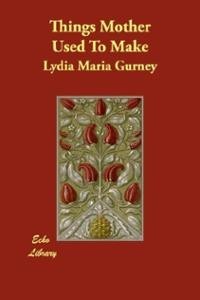
New Englander Lydia Maria Gurney collected recipes handed down from generation to generation, and tested most of them in her own kitchen. In her foreword she explains, “These recipes and Household Hints are written very plainly, for those who have had no experience. . .They are very simple, not expensive, and if followed closely, will ensure success.”
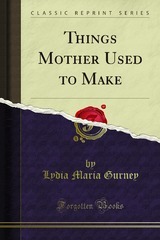
by Lydia Maria Gurney
One of the biggest challenges when researching 19th century American recipes is that most home cooks never used recipes. They simply knew, from practice and tutelage from mothers, sisters, aunts, grandmothers, and hired cooks. Ingredients were understandably simple. In the American West Victorian Era, homesteaders and townsfolk used what they grew, harvested, and could obtain from a general store.
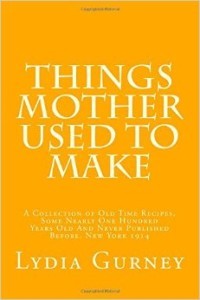
The recipes in Lydia Maria Gurney’s book are true to mid- and late-nineteenth century cooking. While one version was created in 1922, an earlier (first of the Amazon shop buttons, below, on the far left) version was released in 1913, but had been in print previously (“This material was originally published in Suburban Life, where it obtained such recognition as seemed to warrant its preservation in book form.”). This history-worthy title is now in the Public Domain, hence its many varied versions available in print and digital.
The formatting of both print books and digital leaves much to be desired. Ingredients are listed in paragraph form without breaks between. Often the instructions are out of order, convoluted, and difficult (for my 21st-century experience in the kitchen) to follow. I imagine my great grandmother, a contemporary of Ms. Gourney, would have found it a simple read and easy to follow.
The recipes are organized by type:
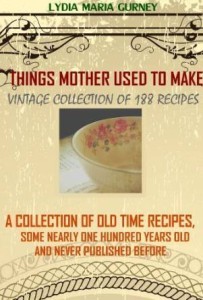
1. breads of all kinds,
2. cakes (interestingly enough– includes cookies),
3. candies,
4. desserts,
5. eggs,
To Boil Eggs:
Put your eggs into a bowl which can be sent to the table. Pour boiling water over them and let stand eight or ten minutes. It is essential that the water be boiling. This way of boiling eggs, though so simple, is going out of fashion, unfortunately, as it makes a wonderful difference in the appearance of the egg when broken open, and above all, in its digestibility. Eggs should never be boiled in any other way for invalids.
~ Things Mother Used To Make: A Collection of Old Time Recipes, Some Nearly One Hundred Years Old and Never Published Before by Lydia Maria Gurney
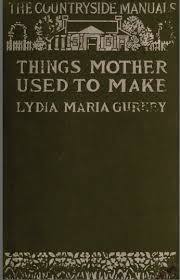
6. fish (she was a New Englander, after all),
7. meat dishes,
8. miscellaneous (Boston Baked Beans, Crust Coffee, Mince Meat, Pickles, etc.),
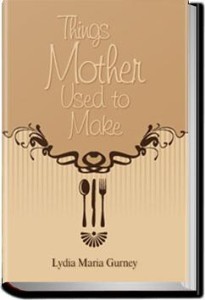
9. pies
10. preserves (including bread pudding, steamed chocolate pudding, and graham pudding– apparently just out of order and in the wrong category)
11. sauces
12. soups 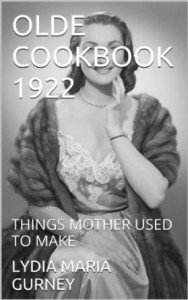
13. vegetables
14. appendix (Household Hints Old and New for Housekeepers Young and Old, a recipe for homemade shortening, how to store eggs from the abundance of summer clear through winter, washing lamp chimneys, removing disagreeable odors from house, how to clean nickel stove trimmings, how to make old velvet look new, using onion skins as a dye, and how to color lace ecru… and so much more.
In short, this book is an historian’s dream.
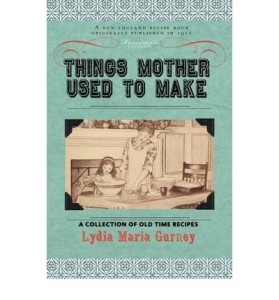
The recipes and instructions are true to the era as evidenced by the simplicity of ingredients, scarcity of instructions (everyone knew what “sour milk” and “scald” meant), and measurements (“the size of half an egg”, “1 dessertspoonful of salt”). What is a dessertspoon? My 21st-century measuring spoon set doesn’t have a “dessertspoon”. In case you’re interested, a dessertspoon is equivalent to approximately 2 teaspoons.
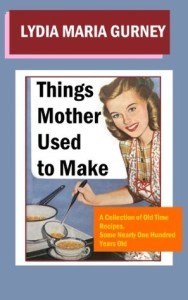
Regarding sour milk, the appendix emphasizes: Never Throw away Sour Milk [sic]. It is excellent for graham bread, gingerbread, brown bread, griddle cakes, and doughnuts, also biscuit [sic].
One more element I can’t wait to try in my modern-day homemade (from scratch) chocolate cake: “Yolks and whites, beaten separately, make a cake much lighter than when beaten together.” At least one cake recipe and one omelet recipe contained in this treasure trove instructs beating yolks and whites separately, but doesn’t explain why. Now we know!
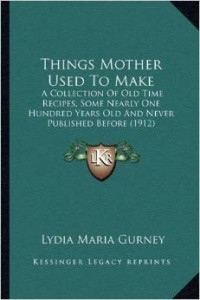
I learned so very much about the history of food in the 19th Century American northeast (easily translatable to the West… as that’s were the vast majority of immigrants came from). I chuckled. I asked my mother and grandmother lots of questions. I found myself curious and interested and reminded of more modernized versions of old-fashioned favorites.
For example: Cream Pie. Yummy! Maddox Ranch House is an icon of Northern Utah restaurants. One-of-a-kind, scrumptious beef, chicken, bison, and seafood. Potatoes. Yeast rolls to die for. And old fashioned cream pie. I can’t dine there without wanting a slice at the end of an incredible meal, all the better for the raspberry sauce on top.
RICH PIE CRUST
3 Cupfuls of Flour
1 Cupful of Lard
1 Dessertspoonful of Salt
Put salt and lard into the flour, working in the lard with the hand until thoroughly mixed. Add enough water to barely wet,–ice-cold water is best. This is sufficient for two pies.
CREAM PIE
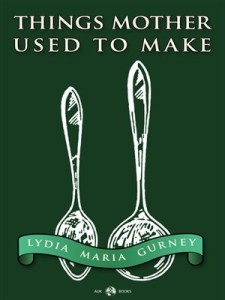
1 Cupful of Sweet Cream
White of One Egg
2/3 Cupful of Sugar
1 Teaspoonful of Vanilla
Bake with two crusts. Beat white of egg till stiff; add sugar, beat again; stir in the cream and flavor.
~ Things Mother Used To Make: A Collection of Old Time Recipes, Some Nearly One Hundred Years Old and Never Published Before by Lydia Maria Gurney
That’s it. No baking temperature… not even “moderate oven” or “hot oven”, and no length of time. Why? Because such things were common knowledge. Like how to wash a dish or sweep a floor, children learned everything about it from the time they helped around the house. Mothers taught their daughters (and often, their sons) as a matter of a life’s education.
Whether this book catches your eye because you’re a fan of baking, a “foodie”, a student of all things history, or simply find the subject interesting, I recommend it. Particularly because at least one Kindle version is FREE ($0.00 to own). (See first box, below, lower left-hand side.)
Both print and Nook versions are available at BN.com
Copyright © 2015 Kristin Holt, LC
September 25, 2015
NEW RELEASE: Opening Scene
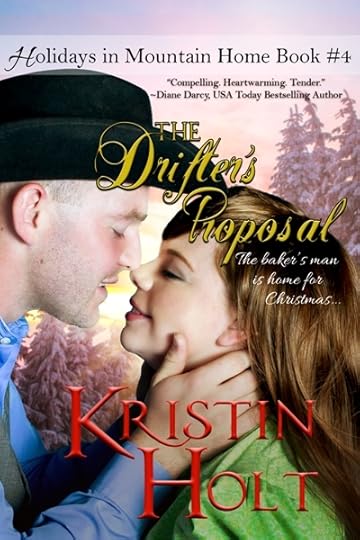

The Drifter’s Proposal
Opening Scene
Subject to Change
Copyright © 2015 Kristin Holt, LC
Mountain Home, Colorado
December, 1900
Adaline Whipple accepted Mr. Malloy’s payment for a thick slice of raisin bread, spread thick with whipped cinnamon butter. His fingertips brushed her palm as she accepted his coin. She forced her attention away from his startling blue eyes.
A woman could drown in those pools, bluer than a deep, summertime lake reflecting cloudless skies.
“Obliged, ma’am.”
And that voice. Deep, rich, and on the border of raspy.
She doubted he knew her name yet her insides fluttered, and like a silly girl half her age, she tracked him to the last remaining empty table. Bright sunlight streamed through the bay window, warming his freshly shaved jaw and single-minded focus on his breakfast.
Warmth gathered in her belly, watching him close his eyes, savoring the mixture of buttery bread and cinnamon-sugar. He licked a dripping finger and her weightless tummy rolled all the way over.
In too many daydreams, he looked at her with the same single minded focus, the same absolute adoration. Oh, what it would be like to be courted by him… or have him even notice her as more than the clerk behind the bakery counter.
Shameful, her fixation on Malloy— the stranger who’d become a daily customer, a regular, over the past three months. How he had time to dally in the bakery while working the Erickson spread, she had no idea.
The bells tinkled and a wash of frigid air entered with a customer. A gentleman, outfitted in a finely tailored overcoat and stylish silk top hat. He swept the hat from his head and approached the counter.
Usually, customers scanned the blackboard for listed offerings or searched the display case in order to make a selection. But this citified dandy searched the nearly full dining area, then peered past her into the back, obviously looking for someone. Sandy brows lowered over dark eyes. His heavy mustache, well-trimmed and curled at the outer corners with pomade, twitched. Fashionably styled hair shot through with a touch of gray at the temples put him at roughly her parents’ age.
Adaline didn’t know him. “Might I help you, sir?”
“I’m here for Mr. Thaddeus Whipple.”
Grief, a constant companion, perked up its ears. She swallowed, fighting down the still too-familiar sensation. “Gone from this world.”
The gentleman spun his hat in his hands. “Would you be Mrs. Whipple?”
“Miss Whipple. His daughter.”
“Might I speak with your mother?”
No condolences. No change of expression. Not a businessman Father had ordered supplies from, then. Notably, the dandy hadn’t introduced himself.
Whatever this was about, he’d deal with her, and her alone. Mama’s health and constitution had been… fragile… since that fateful September day.
“You’ll address this with me. Mother isn’t well.”
As if hesitant, he withdrew a sheaf of papers from his breast pocket, tapped it against the polished oak counter top, and finally met her gaze. “As I said, this is a matter of business. I believe we ought to sit down with your mother.” Another tap-tap of folded papers. “Somewhere private?”
Adaline glanced at the customers filling the dining tables. They’d want coffee cups refilled. She had a fresh batch of rolls rising in the back. In less than five minutes, crusty loaves of wheat bread would need pulling from the oven. At the moment, no customers waited in line behind this fellow, but that could easily change. He’d caught her at one of their busiest hours, and on a Saturday morning, when half the town bought fresh bread, rolls, and sweets for Sunday suppers.
“That’s not possible.” She held her ground. “Suppose you tell me what this is about?”
“All right, then.” He spread the folded documents between them with blunt, well-manicured hands. He spun the pages about to face her right-side up.
Her gaze latched onto a most familiar signature at the bottom.
Papa’s penmanship.
Familiar, sharp grief sliced through her. Sometimes it seemed she could still hear his cheerful whistle. Long quiet hours often felt as though he’d just stepped outside, and he’d burst through the kitchen door, a wide grin on his dear face at any moment.
Apparently, a mature woman of twenty-five still needed her papa.
“Do you know what this is?” The man’s carefully styled mustache lifted in a most ungentlemanly smirk.
Adaline cleared grief, thick as cold butter, from her throat. She scanned the document from the top. M-O-R-T-G-A-G-E, with flourishes and fancy typeset, printed on quality letterhead stock.
Bearing Father’s signature.
No, no, no!
Too aware a dozen regular patrons could easily overhear the conversation, Adaline set her jaw. She held the stranger’s gaze while her heart pounded wildly. “Suppose you tell me why you’re here, Mr…?”
“Forgive me,” he murmured, offering his hand.
She refused to take it.
“Why, I’m Mr. Sheridan Lockhart with First National Bank in Denver City.” He waited, still expecting her to shake hands. The moment eventually passed and he withdrew.
“Do you know,” he repeated, “what this is?”
Lockhart had a way about him she most certainly did not like. She’d love to punch him down to size like an over-risen batch of bread dough.
“I can read, Mr. Lockhart.” She lowered her voice, hoping he’d follow her lead and lower his. After all, this was a private matter.
If Papa had mortgaged the bakery— everything their family relied upon, all they had— she’d have known. Wouldn’t she?
Sound came rushing back, as if a spring thaw had occurred all at once. The rattle of coffee cups on saucers. The scrape of boots across polished wood floors. She found her strength, movement, and snatched up the proffered documents for a closer look. Her hands trembled.
“I regret to inform you, Miss Whipple, I’ve come, on behalf of First National Bank, to collect. The mortgage payment is sixty days past-due, and per the contractual agreement, the balance must be paid in full.”
Embarrassment flushed, surely coloring her cheeks. All noise in the shop ceased. Winter wind battered the side of the building, and the cozy bakery suddenly felt far too warm. Somewhere amongst her guests, a fork clattered to a plate, leaving her with the most ridiculous sense that all present had heard the banker’s condemning words.
Due in full.
I’ve come to collect.
Mortgage.
Past due.
Oh, the humiliation!
The register held less than five dollars. Just enough to make change.
The local Bank of Mountain Home had her parents’ accounts, sure, but…
Did Mama know about this?
Adaline snagged on the staggering sum and shocking, ridiculous monthly payment…
How had Papa ever thought he could repay this? And at such exorbitant rates? Yes, the holidays always brought a brisk business, but if Pa had taught her anything, he’d taught her not to count on money not yet in hand. Why would he preach against the evils of mortgaging hard-earned property, yet sign away his life’s earnings in secret?
Her heart pounded double-time. The address of this property was correct. Father’s full name. The family’s residence above the shop, too.
Oh, dear God in heaven, what had Father done?
“Miss Whipple?”
Though Adaline’s ears rang, her gaze snapped back to the banker. She opened her mouth to respond, but words failed her.
His features arranged in an expression most contrite. Apologetic, even. “I see we’ve caught you ill-prepared for such news.”
“Indeed.” Just how was a woman in her predicament to act?
Lockhart leaned on the counter, invading her space. He carried the pungent fragrance of too much Bay Rum. Her stomach rebelled. “Perhaps we should complete this transaction somewhere more private.”
She hadn’t the money to pay this debt, at least she didn’t as far as she knew. After the funeral, she’d worked twice as hard, doing her work and Father’s, just to keep the bakery operating.
Why hadn’t she made time to review the business finances?
Humiliation burned all the way to the tips of her ears.
No matter the bank balances, it surely wasn’t enough to pay off the loan, or Father wouldn’t have sought a mortgage in the first place.
She simply had to delay, send this bank representative away, talk with Mother, and figure out what to do. “Is this my copy of the mortgage?”
“No, ma’am. That’s the original. Your father received his copy the day of the loan’s origination.”
Where would Papa have put it? Mama’s writing desk? In a drawer of the business desk, in the back?
Lockhart cleared his throat. “I assume your business funds are kept locally. I’ll accompany you to the bank, so you might make the necessary withdrawal.”
“I have bread in the oven, a business to run.”
Lockhart smiled easily. “For the moment.”
Adaline started. Why, the blatant threat—
Heat surged up her neck, no doubt flushing her face. She blinked, realized conversation among the regulars had ceased. Most simply stared, stopped eating. Oh, what they must think!
The banker made a condescending tisking sound and shook his head ever so slightly. “The payments are already sixty days past-due. I can’t delay the bank’s actions to recoup losses.”
“You’ll wait,” she informed him, vinegar in her tone, “twenty-four hours or more.”
He shook his head, condescension thick as icing on a three-layer cake.
“Sir, you’ve caught me unaware. I require time to discuss this with my mother.”
He inclined his head, just a notch, but enough to convey he understood her. “Very well. Twenty-four hours, it is.”
He gestured for the documents.
She wanted him gone so she could confront her mother, so she shoved the documents across the counter to Lockhart.
Without so much as a good day, Sheridan Lockhart strode through the door, set the bells to jangling, and let the cold air in.
Rage choked her.
Against her better judgment, her gaze sought Mr. Malloy’s bottomless blue eyes—a man whose calm confidence always seemed to soothe… though he had no way of knowing he had such an effect on her.
But he was already gone.
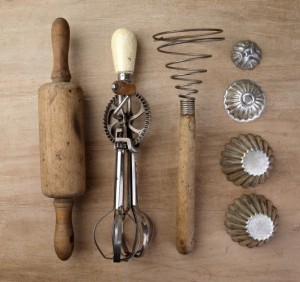
The Drifter’s Proposal is my contribution to Silver Belles and Stetsons, available NOW for Preorder (Releases November 2, 2015). The single-title with the individual book cover, pictured above, will be available for Preorder on October 6, 2015, and releases November 16, 2015.
Related Post– NEW RELEASE: Coming November 2nd (Preorder Available)
Copyright © 2015 Kristin Holt, LC
Kristin Holt's Blog
- Kristin Holt's profile
- 117 followers



